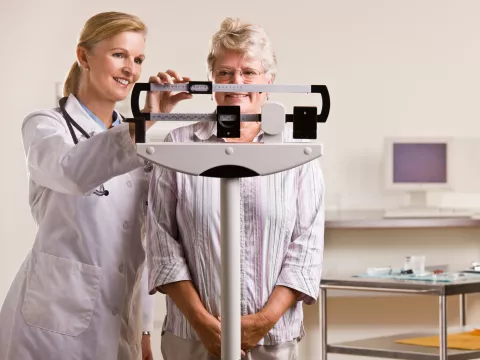- AdventHealth

Cholesterol levels get most of the attention. It’s true that having high levels of LDL, or “bad,” cholesterol and low levels of HDL, or “good,” cholesterol puts you at a greater risk of heart disease. But they’re not the only important readings on your lipid panel. Your primary care provider should talk with you about your triglycerides, too.
What’s a Triglyceride, Anyway?
Triglycerides are a type of fat. Your body produces some of it, and you get some from the foods you eat.
After you eat, any extra calories that your body doesn’t need immediately get turned into triglycerides. They’re kept in fat cells for storage. When your body needs energy, it releases the triglycerides into the blood.
When your provider draws blood to check your overall cholesterol, he or she will also get a triglyceride count. You may need to fast for eight to 12 hours first. Your health care provider may also ask you to avoid drinking alcohol. Be sure to double check with your provider how to prepare for the test.
According to the American Heart Association, there are four categories of triglyceride levels:
- Normal—lower than 150 mg/dl
- Borderline high—between 150 and 199 mg/dl
- High—between 200 and 499 mg/dl
- Very high—500 mg/dl or higher
What Causes Triglycerides to Rise
Several factors can contribute to high triglyceride levels. These include:
- Being overweight or obese
- Not getting enough exercise
- Type 2 diabetes that isn’t well-controlled
- Problems with your kidneys, liver, or thyroid
- Smoking
- Drinking too much alcohol
- Some genetic disorders
- Eating a high-carb diet, or a diet high in processed or sugary foods
- Certain medications, such as beta-blockers
Why High Levels Are a Concern—And What to Do About Them
Researchers aren’t quite sure why, but high triglycerides boost your risk for heart disease—especially when combined with other components of metabolic syndrome. They seem to interact with cholesterol to produce extra fatty buildup in your blood vessels. Eventually this blocks blood flow to your heart, damaging the muscle.
Very high triglyceride levels can also harm your pancreas. And some evidence suggests that women with high readings during pregnancy might be more likely to develop gestational diabetes mellitus.
What is clear is that making changes to your lifestyle can lower triglyceride counts. If you’re in the borderline high or high groups, your provider may talk with you about:
- Cutting saturated fats and trans fats from your diet. Replace them with unsaturated fats, such as those found in canola or olive oil.
- Reaching a healthy weight. If you’re overweight, shedding just five to 10 percent of your weight can lower triglycerides.
- Working out. Aim for at least 150 minutes of moderate aerobic activity or 75 minutes of vigorous aerobic activity a week. Try walking, biking, swimming, or gardening— anything that gets your heart beating faster counts.
- Eating more fruits, vegetables, and nonfat or low-fat dairy products. Also add more fish to your diet. The omega-3 fatty acids in salmon and tuna are good replacements for the saturated fats in hamburgers.
- Avoiding alcohol. Cutting back can cause impactful changes in lowering your triglycerides.
Sometimes, your health care provider may prescribe medications to help lower triglycerides. Statins, which lower LDL cholesterol levels, may also help regulate triglyceride levels.
To reach one of our whole-health experts, call us at Call844-362-2329.



